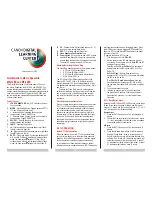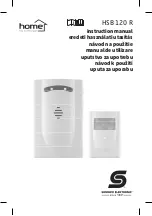14
V2002D-PTZ
User’s Manual
DSCP: 0 ~ 63
To classify and manage network traffic and provide quality of service (QoS) on modern IP networks,
Differentiated Services Code Point (DSCP) is a computer networking architecture that specifies a
resource allocation to each device on a priority-based pattern for ideal bandwidth management. The
bigger value, the higher priority it will be.
Rate Control: CBR/VBR/CVBR
Choose one of the Rate Control modes depending on different situations. Higher bit rate value will
result in better image quality with bigger file size and therefore consume more network bandwidth,
while lower bit rate value has less loading on network bandwidth due to smaller file size but with
inferior image quality.
CBR Bit Rate/Max Bit Rate: 64 ~ 20000
The default bit rate synchronizes with the maximum resolution. It is recommended to use the default
bit rate, as it provides better balance between image quality and network bandwidth.
When bit rate value lower than default bit rate is selected, the image quality may deteriorate.
When selecting bit rate higher than default bit rate, there is a correlation between resolution and
selected bit rate. Higher maximum resolution cameras are better suited to selection of bit rate higher
than default bit rate than lower maximum resolution cameras.
Note
CBR Bit Rate option is available only when CBR Rate Control is selected.
Max Bit Rate option is available only when CVBR Rate Control is selected.
Quality Level: VBR/CVBR: 1 ~ 10; MJPEG: Low/Mid/High
Select the Quality Level number from 1 to 10 for H.264/H.265 Codec with VBR Rate Control selected, or
Quality Level Low/Mid/High for MJPEG Codec. “High” or “larger value” produces the highest image
quality but increases the file size. By contrast, “low” or “smaller value
,
” produces the lowest image
quality with decreased file size and network bandwidth consumption.
Note
Quality Level option is available only when VBR Rate Control is selected, or when
MJPEG Codec is selected.
Codec: MJPEG/H.264/H.265
MJPEG: Each video frame is individually compressed as single jpeg image with full-scale contents
and can be retouched easily. However, this results in larger file size and therefore tends to lose
frames under limited network bandwidth.
H.264: This widespread video compression format adopts intelligent technology to record variations
in each frame rather than record each full frame. As a result, less network bandwidth is required,
and file size tends to be smaller compared with the MJPEG codec.
H.265: Also known as HEVC (High Efficiency Video Coding), H.265, the latest video compression
standard, provides almost double the compression ratio at the same level of video quality
compared with H.264. It efficiently reduces the redundant areas among different frames by using
pattern comparison, enhanced difference-coding areas and variable-block-size segmentation.
Note
Rate Control, Max Bit Rate, CBR Bit Rate Profile, SVC-T, and GOP options are NOT
available when MJPEG Codec is selected.
Summary of Contents for Roughneck Pro V2002D-PTZ
Page 98: ......


















